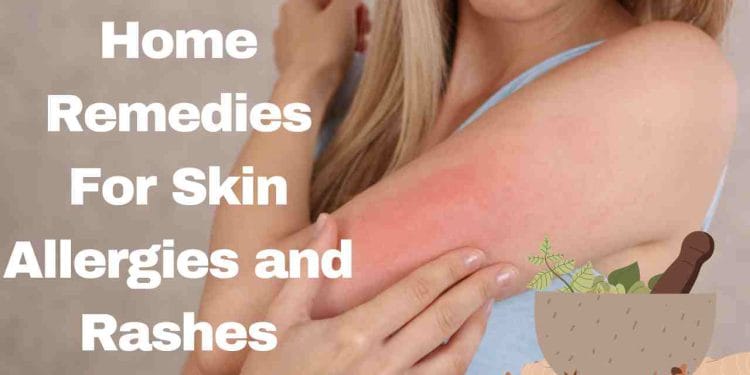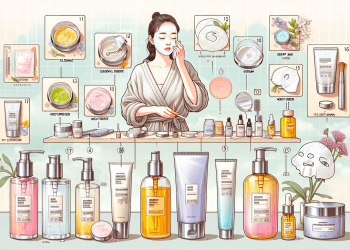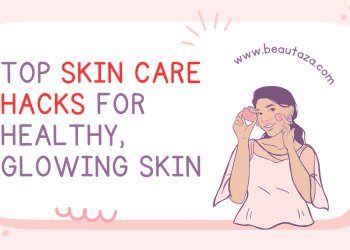
This blog post will discuss Home Remedies For Skin Allergies and Rashes.
Why is your skin red, bloated, painful, and itchy? Possible rash. Many medical disorders cause rashes. Possibly allergies or irritants. To treat a rash, you must discover its cause. A rash may occur if you are allergic to certain substances. Thus, skin allergies may cause rashes.
Itchy rashes are not contagious. It doesn’t spread. You can relax your skin using natural skin rash remedies. First, a few things are discussed.
What Are the Causes of Skin Rashes & Allergies?
Some environmental elements like pollen, mold, or chemicals from plants and animals may induce allergic responses on the skin, particularly during the summer or spring.
A few types of grass and plants might result in allergic skin rashes.
Heat and sweat may cause hives (urticaria) to break out.
Your eczema (atopic dermatitis) might worsen if you sweat a lot.
An allergen that irritates the skin leads the immune system to get activated, which results in a skin rash. The name of this ailment is allergic contact dermatitis, where dermatitis refers to skin irritation. Several of the reasons include:
Poison ivy is the most frequent cause.
Plant-based compounds known as botanicals
antibiotics plus a few additional drugs
fragrances that might come into touch with your skin
Preservatives
Metals
Rashes and Skin Allergy Symptoms
As was already said, there are a variety of causes for skin allergies and rashes. It happens minutes, hours, or even days after exposure to an allergen. Allergic contact dermatitis is the medical term for the symptoms that appear whenever an allergen touches our skin. You can identify it whenever it occurs by noting that the rash:
being redIt will itch and maybe burn or sting.
It could hurt if the rash is accompanied by flaking or peeling skin.
may swell, ooze, or be scorching.
Possibility of swelling and hive-like symptoms (skin itchiness and puffiness).
Skin allergies and rashes can be treated at home with the following:
We often get skin allergies and rashes because we come into contact with many things that could cause them. There are different ways to treat these spots; your doctor will tell you what to do. Even if the treatment starts right away, it could take a while for the rash to go away. But if you want to try natural treatments for rashes and skin issues, you can try home remedies for skin rashes.
Chamomile in Germany
Matricaria recutita L. is the Latin name for German chamomile. The flower can be put on the skin to treat redness, acne, eczema, and many other allergic skin problems. Studies on humans show it is better at treating toxic dermatitis caused by chemicals than hydrocortisone, found in creams used to treat spots. You can make tea from a few teaspoons of German chamomile leaves and drink it to treat skin allergies at home. It is also a part of some ointments that you can buy. You can also use the German chamomile flower extract by mixing the flowers and gently putting it on the rash.
Sage Leaf
Sage leaf is one of the things you can use to treat rashes at home. It is a medical plant that grows in the Mediterranean region. Research conducted on animals and laboratory settings has revealed that specific chemicals found in linseeds, particularly those in sage, aid in diminishing inflammation. This is bad for children under 18, pregnant women, or nursing. Sage oil made from sage leaves can treat skin rashes at home. Use a cotton swab to apply the oil to the rash gently.
Evening Primrose
A scientific study showed that evening primrose can help lessen the signs of atopic eczema. It was also found that putting it on spots made the symptoms of eczema go away. So, evening primrose can be used to treat skin allergies at home. It could help reduce redness, dryness, itching, and the shedding of dead skin cells. Please remember that people with schizophrenia and epilepsy, children, and women who are pregnant or nursing shouldn’t use it. By putting a few drops of evening primrose essential oil in tea and drinking it, you can use it as a natural home treatment for skin problems.
Fenugreek Seeds
Traditional plant medicine uses fenugreek seeds to treat acne and mild local skin redness. Animal tests showed that fluid from fenugreek seeds helped reduce inflammation. Children and teenagers under the age of 18 shouldn’t use it. You can use it to treat skin allergies at home by boiling a few fenugreek seeds and washing them in that water.
Aloe Vera Gel
In animal tests, aloe vera juice reduced acute (severe) skin pain. Aloe vera juice can help reduce inflammation because it has enzymes, sterols, and carbs. It can be put on the skin to treat minor skin irritations and diseases that cause skin irritation. Rarely, it can cause an allergic reaction on touch, so be careful when using it. As a natural way to treat skin rashes at home, you can get the gel from a fresh aloe vera leaf and put it on the rash. It might help your skin rash feel better.
Oats
The Latin name for oat straw is Avenae stratum. It has a lot of chemicals that are good for you. It can treat many skin inflammations and seborrheic (scaling and flaking of the skin caused by a disease) skin conditions, especially those that cause itching. You can use oats as a home remedy for skin rashes by mixing a small amount of oats with curd and honey and putting the mixture on your skin rashes. This can be one of the home treatments for a skin problem on the face.
Oak Bark
People have traditionally used oak bark as a plant medicine to treat minor skin pain, skin diseases that cause pus from skin spots, and eczema that blisters and leaks fluid. Some people who use oak bark get rashes, so be careful if you use it. Using oak bark for over a week or on children and teens younger than 18. You can use the oak tree’s bark to treat skin problems at home by putting oak bark or essential oil in your bath. A few natural remedies for skin problems also contain oak bark.
Flaxseeds
Linseeds, also known as flaxseeds, are derived from the plant species Linum usitatissimum. It is grown worldwide, but most come from India, Turkey, Morocco, and Argentina. It has a lot of bioactive ingredients and may have qualities that soften (emollient), soothe (demulcent), and reduce inflammation, which is good for skin allergies and rashes. You can make a warm ointment out of flaxseeds by putting them in a cloth, warming them up slowly, and then putting them on bumps and spots. You might get some of its benefits by putting it in your food.
Even though some studies show how herbs and home remedies help with the condition, they are not enough.
If you have any of the following signs, you should see a doctor: Home Remedies For Skin Allergies and Rashes.
You may need to contact a doctor if the reaction or rash disappears after a week of therapy.
After a prolonged absence, if the rash or skin allergy returns,
You should consult a doctor if the rashes are painful, itchy all the time, have boils on them, or seem sickly (red, bloated, or heated).
Conclusion: Home Remedies For Skin Allergies and Rashes.
A rash could cause a red spot that hurts and swells up. A skin reaction to an animal, plant substance, or metal could have caused your rash, etc. An inflammatory response to allergens (substances that cause allergies) is the primary cause of most skin spots. So, to treat it right, you need first to find out what caused it. Even after all of this, the rash might not go away for a while. You can treat skin issues at home with oak bark, flaxseeds, aloe vera juice, and German camomile. But if the rash gets worse and doesn’t go away or you see signs of infection (like redness, swelling, and heat), you should see a dermatologist (a doctor specializing in skin and hair) and get their help.
Read –






